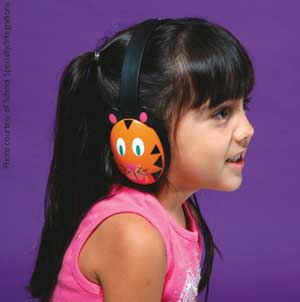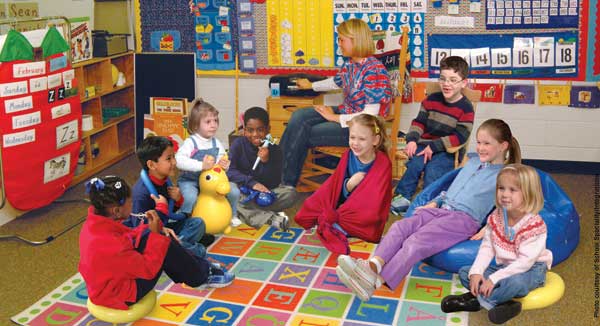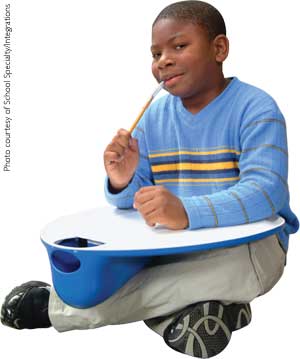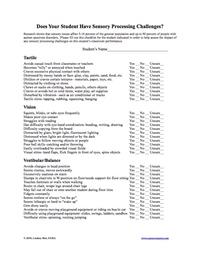Working with Schools
from Raising a Sensory Smart Child
Most kids with mild sensory problems and no other issues do just fine learning and socializing at school with a bit of understanding, extra support, a sensory diet, and a few simple accommodations. You may be able to work this out informally with your child’s school. However, a child with sensory processing disorder (SPD) may need more help to thrive in the classroom and elsewhere at school (the cafeteria, gym, art class, etc.).
If your child qualifies for special education services, he will receive an IEP (Individualized Education Plan), created cooperatively by you and the school, that spells out how the school will meet his unique needs, providing a free and appropriate education (FAPE) in the least restrictive environment (LRE). In plain English, that means that children cannot simply be placed in a special education classroom that doesn’t meet their needs. The object is to figure out how to help the child function in a less-restrictive, appropriate classroom. As a parent or professional, you can help tremendously if you develop your sensory smarts, and use good observation skills and creativity to make the school environment and the child’s needs a better match.
504 plans
If your child with sensory issues doesn’t receive special education services, he can still get help through a 504 plan. A 504 plan is a formal document that states what accommodations must be made for your child, such as allowing her to eat lunch somewhere other than the noisy cafeteria, having more time allotted for taking tests, and so on.
IEPs
If your child receives special ed services, his IEP will spell out specifics such as school accommodations (preferential seating, sensory diet activities and others), assistive technology, therapeutic and educational goals, and mandates for related services such as OT, physical therapy, and speech therapy. A wonderful book for helping you understand the IEP process and your rights, deal effectively with the school system, and resolve disputes is The Complete IEP Guide: How to Advocate for Your Special Ed Child by Lawrence M. Siegel. You may also want to check Wrightslaw for articles, information, and a blog on special education rights.
Avoiding Sensory Overload at School

There’s a big difference between “bad behavior” and “sensory overload.” You can help the school recognize and manage this by describing what overwhelms your child, what overloaded behavior “looks like,” and what actually helps to avoid getting overloaded in the first place. Doing so get school staff more invested in supporting beneficial activities, ideally for all students. While needs vary from child to child, opportunities to obtain the sensory input a child’s nervous system craves and to avoid noxious sensory experiences should be provided across the board. We all need to “wake up” by moving after sitting for a long time, and an occasional break from the intense sensory stimuli in noisy, busy environments such as school, but for kids with sensory issues, brief respites may be crucial in order to remain focused, calm, and attentive throughout the school day.
A sensory diet at school might include:
Walking. Taking a brief walk at specified intervals, perhaps accompanied by an aide.
Brushing. Going to the bathroom, where he can enter a stall and brush himself using the deep touch pressure technique for sensory defensiveness taught by his occupational therapist.
Listening to calming music. Using an iPod or other audio player, the child can listen to music that helps him regain his composure: nature sounds, classical music, or even rock n’ roll—whatever effectively organizes his unique nervous system.
Fidgeting with objects. Fidgets such as a Koosh ball, fabric tab sewn in to a pocket, or even a hair band can keep a student’s hands busy so she can focus better. b Desk accommodations. A band of stretchy material around front chair legs that he can push his shins and ankles against may help. A carpet square or piece soft cloth he can touch attached to the underside of the desk or an inflatable cushion to sit on can make attending for long periods easier for every child.
Objects for chewing. Objects to chew on such as a Pencil Topper, ChewEase, or Chewable Jewel can provide soothing oral input to keep a student focused on learning rather than sensory cravings.
Push-ups and jumping jacks. Jumping jacks or just jumping in place, and push-ups done in a chair or against a wall provide organizing proprioceptive input at school.
Stretching. Stretching wakes up the body after a quiet activity. Everyone can benefit from stretching after sitting, but it’s even more important for a child with sensory issues.
Playground and gym opportunities. All children—especially those with sensory challenges—need opportunities to move before, during, and after school: hang from monkey bars, throw or push objects, run, jump, and pull objects. Otherwise, it can be quite difficult to settle in to quiet classroom activities and obey school rules about “no throwing” and “no running.” More progressive schools incorporate movement experiences such as Brain Gym, yoga, or other fun activities into classrooms to keep students on track and ready to learn. The best gym teachers let kids run laps around the gym to blow off pent-up energy before asking requiring them to sit down and listen to instructions for the day’s gym class.
A sensory smart OT can help you identify activities that will be most helpful before, during, and after school. If your child’s body needs movement to stay tuned in, make sure that recess and gym are never withheld as a punishment, and get this added to your child’s IEP.
Appropriate demand for eye contact. A child with sensory issues may need to “block off” his visual sense in order to listen more effectively. He should not be required to maintain eye contact when answering a question requiring concentration. If increasing eye contact is a goal, it should be worked on at other times, not, for example, when he is making a nerve-wracking oral presentation.
Prepare for intense sensory experiences. The sensitive child should be warned in advance about fire drills, for instance, so she can be prepared for the intensity. She should be permitted to wear earplugs or sound blocking earmuffs during such a sensory onslaught.
Special place in line. When lining up with other children, the child should always be at the front or end of the line so she isn’t disturbed by other children crowding or bumping into her. (You might ask the teacher to appoint her “line monitor” so this doesn’t seem like a punishment.)
Special seating. A sensitive child needs a well-considered seat location in the classroom and other rooms such as art, music, and computer lab. The best spot varies from child to child and the parent, teacher, and OT may need to collaborate to determine the best location in a given room. Children with sensory issues often do best in the front of the classroom close to the teacher, away from distractions such as direct sunlight and vents and noisy radiators. A student may also need to sit where she can’t see out the door or windows, or next to a wall for a sense of security.

Trouble at Circle Time and Listening Time
Most schools require children of all ages to sit still, be quiet, and listen for increasingly long periods as they mature. This does not come easily for many children, especially those who are sensory seekers. Accommodations might include:
-
An inflatable cushion that allows kids to wiggle a bit while remaining seated on a chair or the floor.
-
Hand fidgets that keep hands busy and out of trouble, such as poking the child next to him.
-
A Time Timer can help students “keep it together” by giving them a visual cue about how much longer they are expected to be quiet or focus on a given task.
-
A weighted lap pad or weighted vest. Weighted wearables provide calming sensory input as well as a physical cue to stay in place. Please see Raising a Sensory Smart Child for wearing recommendations and precautions.
Help the sensitive child to not feel singled out! Most kids resist looking “different” from peers, so be sensitive to the desire to fit in. Ask your child for ideas about how he can self-calm. Perhaps gum chewing helps, but the school won’t allow it. An appropriate item to chew, such as a Pencil Topper placed on the pen, might work instead. Provide several of these for the classroom so your child isn’t the only one with “funny pencils.”
Tests, Classroom Assignments, and Organization
Test accommodations. A child with sensory challenges may need to take tests in a separate room with fewer children around (to reduce distractions), be given extended time (if she processes information slowly), and be allowed to record answers in any manner (for example, answers may be typed or dictated to someone else).
Accommodations for instructions. A child may need instructions or the day’s schedule to be provided verbally and visually, either written on the board or in writing. This is particularly true for students with auditory and visual processing difficulties.
Organizational help. Children with poor sensory processing are often disorganized in terms of time, space, and objects. Providing accommodations to help him stay organized is not “enabling” him any more than giving a nearsighted child prescription eyeglasses. Over time, the child can be taught, step-by-step, how to become better organized. In the meantime, he may need more help than the average child to stay organized so he can get his schoolwork done on time, according to the directions. Here are some tips:
Backpack and homework check. The teacher or aide helps your child to check his backpack at the end of the day to be sure no items are left behind. He’s given an assignment notebook, which is broken down by subject matter and has room for short notes between teacher and parent. Both teacher and parent sign off on the assignment notebook daily.
Back ups. Your child is able to keep a second set of books at home. If the teacher has an online class page, she can upload the directions for multipart assignments with multiple deadlines. At the beginning of the year, obtain phone numbers and email addresses of other parents who may be able to lend books or provide assignment directions in a pinch.
Concentration accommodations. Your child may sit at a desk by himself instead of a table when working on multi-step, complex assignments, for better concentration.
Visual accommodations. Your child may wear any prescribed eyewear, including colored lenses and sunglasses indoors, that has been determined necessary. He is to be provided with written directions, in a form he can easily read (for example, black on white paper rather than colored markers on a white board).
Help from School-Based Occupational Therapists

School-based OTs often have ingenious ways to help your child thrive at school. A school-based OT may provide direct services to your child simply be available on a consultation basis. The mode of service delivery must be specified in your child’s IEP. Here are some of the ways in which school-based OTs help kids in the classroom, lunchroom, playground, gym, art room, music room, computer lab and elsewhere at school.
Handwriting (“graphomotor”) difficulties, often due to decreased hand strength and stability or impaired proprioceptive processing (pressing too hard or too lightly). Poor writing can also be related to visual processing problems and/or motor planning issues (difficulty developing and carrying out a sequence of movements).
Transition difficulties, such as going from the noisy cafeteria or playground into a quieter activity, can be very challenging for kids with sensory issues.
Playground and physical education issues, including how to use equipment appropriately. An OT may help your child build core strength and endurance, and may show a student how to calm down and transition to quiet activities after intense movement input such swinging or participating in sports makes her wired.
Focusing, attending, and staying organized. A sensory smart OT can help a child learn how to calm and organize his system so that he can better focus and attend to learning.
Difficulties with specialty classes. The routines and environments in special classes such as physical education, art, music, and computer lab can be challenging. Such classes often involve extra background noise (e.g., classmates talking and moving at once) as well as unpleasant odors (e.g., arts and craft supplies) or irritating sounds (e.g., musical instruments or off-key singing). An OT can help a student and specialty teacher develop solutions to these issues, and we provide many suggestions in Raising a Sensory Smart Child.
If your child receives OT at school, check where service takes place. If the service is “pull out,” it means the OT removes your child from the classroom to work in a separate location. That’s great for working on skill development and doing more intense sensory diet work. Be sure, however, to ask the OT visit your child in the classroom too so she can identify and address any needs in the actual room where most of the day is spent. If your child is mandated for “push in” OT services, it means the OT works with your child in the actual classroom. Ask the OT whether she is able to effectively build your child’s skills while in the classroom, and how she can help your child to not feel singled out. Keep in mind that the school-based OT really does want to hear from parents. She would love to hear what you’ve already discovered works well for your child!
Previous (Sensory Diet Activities)



Share this page: